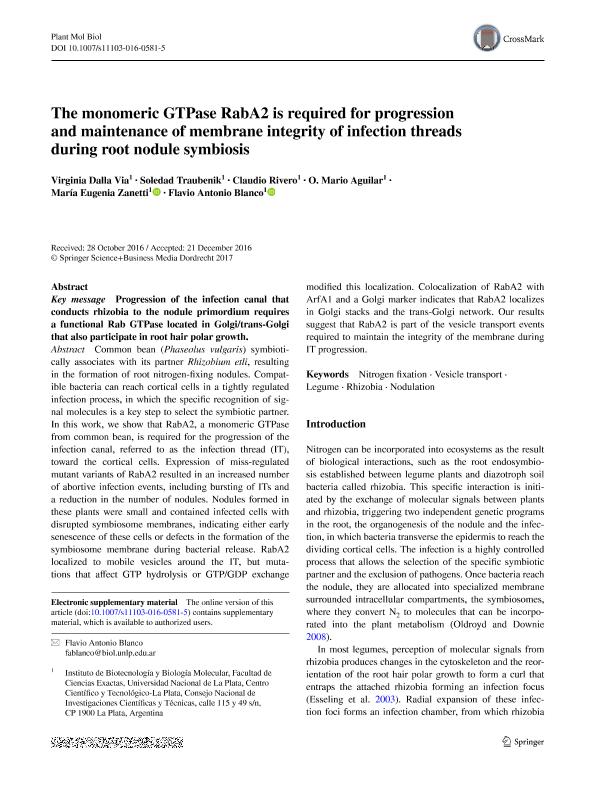Mostrar el registro sencillo del ítem
dc.contributor.author
Dalla Via, Maria Virginia

dc.contributor.author
Traubenik, Laura Soledad

dc.contributor.author
Rivero Hernandez, Claudio Hernan

dc.contributor.author
Aguilar, Orlando Mario

dc.contributor.author
Zanetti, María Eugenia

dc.contributor.author
Blanco, Flavio Antonio

dc.date.available
2018-12-04T14:46:05Z
dc.date.issued
2017-04-21
dc.identifier.citation
Dalla Via, Maria Virginia; Traubenik, Laura Soledad; Rivero Hernandez, Claudio Hernan; Aguilar, Orlando Mario; Zanetti, María Eugenia; et al.; The monomeric GTPase RabA2 is required for progression and maintenance of membrane integrity of infection threads during root nodule symbiosis; Springer; Plant Molecular Biology; 93; 6; 21-4-2017; 549-562
dc.identifier.issn
0167-4412
dc.identifier.uri
http://hdl.handle.net/11336/65708
dc.description.abstract
Key message: Progression of the infection canal that conducts rhizobia to the nodule primordium requires a functional Rab GTPase located in Golgi/trans-Golgi that also participate in root hair polar growth. Abstract: Common bean (Phaseolus vulgaris) symbiotically associates with its partner Rhizobium etli, resulting in the formation of root nitrogen-fixing nodules. Compatible bacteria can reach cortical cells in a tightly regulated infection process, in which the specific recognition of signal molecules is a key step to select the symbiotic partner. In this work, we show that RabA2, a monomeric GTPase from common bean, is required for the progression of the infection canal, referred to as the infection thread (IT), toward the cortical cells. Expression of miss-regulated mutant variants of RabA2 resulted in an increased number of abortive infection events, including bursting of ITs and a reduction in the number of nodules. Nodules formed in these plants were small and contained infected cells with disrupted symbiosome membranes, indicating either early senescence of these cells or defects in the formation of the symbiosome membrane during bacterial release. RabA2 localized to mobile vesicles around the IT, but mutations that affect GTP hydrolysis or GTP/GDP exchange modified this localization. Colocalization of RabA2 with ArfA1 and a Golgi marker indicates that RabA2 localizes in Golgi stacks and the trans-Golgi network. Our results suggest that RabA2 is part of the vesicle transport events required to maintain the integrity of the membrane during IT progression.
dc.format
application/pdf
dc.language.iso
eng
dc.publisher
Springer

dc.rights
info:eu-repo/semantics/openAccess
dc.rights.uri
https://creativecommons.org/licenses/by-nc-sa/2.5/ar/
dc.subject
Legume
dc.subject
Nitrogen Fixation
dc.subject
Nodulation
dc.subject
Rhizobia
dc.subject
Vesicle Transport
dc.subject.classification
Otras Ciencias Biológicas

dc.subject.classification
Ciencias Biológicas

dc.subject.classification
CIENCIAS NATURALES Y EXACTAS

dc.title
The monomeric GTPase RabA2 is required for progression and maintenance of membrane integrity of infection threads during root nodule symbiosis
dc.type
info:eu-repo/semantics/article
dc.type
info:ar-repo/semantics/artículo
dc.type
info:eu-repo/semantics/publishedVersion
dc.date.updated
2018-10-22T19:53:02Z
dc.journal.volume
93
dc.journal.number
6
dc.journal.pagination
549-562
dc.journal.pais
Alemania

dc.journal.ciudad
Berlin
dc.description.fil
Fil: Dalla Via, Maria Virginia. Consejo Nacional de Investigaciones Científicas y Técnicas. Centro Científico Tecnológico Conicet - La Plata. Instituto de Biotecnología y Biología Molecular. Universidad Nacional de La Plata. Facultad de Ciencias Exactas. Instituto de Biotecnología y Biología Molecular; Argentina
dc.description.fil
Fil: Traubenik, Laura Soledad. Consejo Nacional de Investigaciones Científicas y Técnicas. Centro Científico Tecnológico Conicet - La Plata. Instituto de Biotecnología y Biología Molecular. Universidad Nacional de La Plata. Facultad de Ciencias Exactas. Instituto de Biotecnología y Biología Molecular; Argentina
dc.description.fil
Fil: Rivero Hernandez, Claudio Hernan. Consejo Nacional de Investigaciones Científicas y Técnicas. Centro Científico Tecnológico Conicet - La Plata. Instituto de Biotecnología y Biología Molecular. Universidad Nacional de La Plata. Facultad de Ciencias Exactas. Instituto de Biotecnología y Biología Molecular; Argentina
dc.description.fil
Fil: Aguilar, Orlando Mario. Consejo Nacional de Investigaciones Científicas y Técnicas. Centro Científico Tecnológico Conicet - La Plata. Instituto de Biotecnología y Biología Molecular. Universidad Nacional de La Plata. Facultad de Ciencias Exactas. Instituto de Biotecnología y Biología Molecular; Argentina
dc.description.fil
Fil: Zanetti, María Eugenia. Consejo Nacional de Investigaciones Científicas y Técnicas. Centro Científico Tecnológico Conicet - La Plata. Instituto de Biotecnología y Biología Molecular. Universidad Nacional de La Plata. Facultad de Ciencias Exactas. Instituto de Biotecnología y Biología Molecular; Argentina
dc.description.fil
Fil: Blanco, Flavio Antonio. Consejo Nacional de Investigaciones Científicas y Técnicas. Centro Científico Tecnológico Conicet - La Plata. Instituto de Biotecnología y Biología Molecular. Universidad Nacional de La Plata. Facultad de Ciencias Exactas. Instituto de Biotecnología y Biología Molecular; Argentina
dc.journal.title
Plant Molecular Biology

dc.relation.alternativeid
info:eu-repo/semantics/altIdentifier/url/http://rd.springer.com/article/10.1007/s11103-016-0581-5
dc.relation.alternativeid
info:eu-repo/semantics/altIdentifier/doi/https://dx.doi.org/10.1007/s11103-016-0581-5
Archivos asociados
